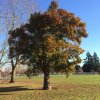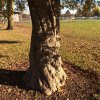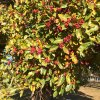I have noticed this tree for years near a neighborhood athletic field and finally had enough wondering to ask others; especially after I noted that the tree has retained its leaves long after the surrounding maples, oaks, and sycamores have lost theirs or are about to (these pics were taken Nov. 26).
It stands about 20 feet tall and equally wide. The tender fruits are not sour with just a hint of sweetness - kinda mealy - with three seeds in each. I’m unsure if the twisting trunk is common to these trees. It kinda reminds me of hawthorns but the leaves are totally wrong and there are no thorns on this tree. I’ve looked through the Audubon North American Eastern and Western tree books with no definitive answer.
Given that this is growing in an urban field on the grounds of where a middle school once stood with an elementary school next door and is maintained for sports, it could be native to anywhere with a similar climate. If it is not native to the Pacific NW, then perhaps there is a story behind it that I’d like to explore.
Any help is appreciated.
It stands about 20 feet tall and equally wide. The tender fruits are not sour with just a hint of sweetness - kinda mealy - with three seeds in each. I’m unsure if the twisting trunk is common to these trees. It kinda reminds me of hawthorns but the leaves are totally wrong and there are no thorns on this tree. I’ve looked through the Audubon North American Eastern and Western tree books with no definitive answer.
Given that this is growing in an urban field on the grounds of where a middle school once stood with an elementary school next door and is maintained for sports, it could be native to anywhere with a similar climate. If it is not native to the Pacific NW, then perhaps there is a story behind it that I’d like to explore.
Any help is appreciated.
Attachments
Last edited:




